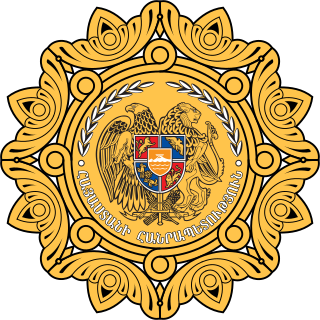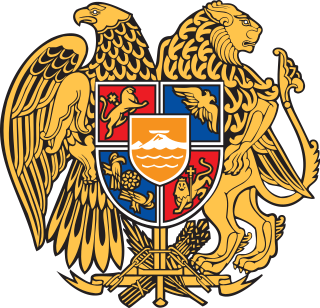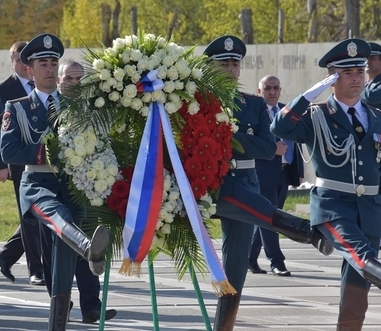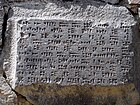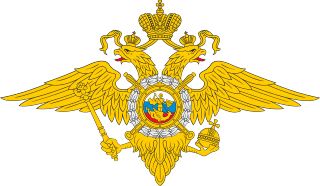
The Ministry of Internal Affairs of the Russian Federation is the interior ministry of Russia. Emperor Alexander I of Russia founded its predecessor in 1802 in Imperial Russia. The Ministry has its headquarters in Moscow.

Hayk Bzhishkyan, was a Soviet military commander of the Russian Civil War and Polish-Soviet War.

The Internal Troops, full name Internal Troops of the Ministry for Internal Affairs (MVD), alternatively translated as "Interior ", is a paramilitary gendarmerie-like force in the now-defunct Soviet Union and in some of its successor countries, including in Russia, Ukraine, Georgia, Azerbaijan, Kazakhstan, Internal Troops of Turkmenistan and Tajikistan. Internal Troops are subordinated to the interior ministries of the respective countries.

Law enforcement in Lithuania is the responsibility of a "unified national police force under the jurisdiction of the Interior Ministry." From the Lithuanian Police Department by the Lithuanian Ministry of Internal Affairs, which is led by the Police Commissar General, the police force branches out to the National and Municipal Police.
Law enforcement in Azerbaijan comes under the control of the Ministry of Internal Affairs of Azerbaijan, which administers the National Police of the Republic of Azerbaijan. Admitted to the Organization for Security and Co-operation in Europe (OSCE) on 30 January 1992, with an OSCE office opening in Baku on 16 November 1999, and as a member of INTERPOL, the National police force is well integrated into the law enforcement network of European countries.

As well as the Militsiya, law enforcement in Belarus is also the responsibility of other agencies such as the Presidential Guard and the State Security Agency of the Republic of Belarus, all under the authority of the country's Ministry of Internal Affairs.

The Ministry of the Interior of the Republic of Croatia is the ministry in the Government of Croatia which is in charge of state security among other roles. Croatian Police is a public service of the Ministry of the Interior.

The Estonian Police was the law enforcement agency of Estonia. It was subordinate to the Ministry of the Interior. In 2010, the organization was superseded by the Police and Border Guard Board.

The Ministry of Internal Affairs of Azerbaijan is an Azerbaijani government ministry for internal affairs, which is responsible for keeping the order, security and safety of population, officials, buildings and structures in the country. The Minister of Internal Affairs of Azerbaijan is appointed and removed from the post by the Commander-in-chief of the Azerbaijani Armed Forces, the President of Azerbaijan.

The Ministry of Internal Affairs (MVD) - Russian: Министерство внутренних дел СССР (МВД) - was a government ministry in the Soviet Union. The MVD, a successor agency to the NKVD, was established in March 1946. Unlike the NKVD, except for a period of about 12 months, from mid-March 1953 until mid-March 1954, the MVD did not include units (agencies) concerned with secret (political) activity, that function being assigned to the Ministry of State Security (MGB), and to the Committee for State Security (KGB).

The Ministry of Internal Affairs of Georgia, abbreviated MIA (შსს), is a state law enforcement agency of Georgia. Its main office is in Tbilisi. The Ministry of Internal Affairs of Georgia is the Head of which (Minister) is a member of the Government. The Ministry is accountable to the Government and fulfills the tasks imposed by it or the Prime Minister. Since November 13, 2017 the Minister of Internal Affairs is Mr. Giorgi Gakharia.

The Moscow Police, officially the Main Directorate of Internal Affairs of the city of Moscow, is the police force for Moscow, Russia.

The Primorsky Krai Directorate for Internal Affairs, is the police department of the Primorsky Krai, in Eastern Russia.

The Ministry of Internal Affairs of Dagestan is the interior ministry of Dagestan in southern Russia. The Ministry is headquartered in Makhachkala. As of 2012 the minister was Abdurashid Magomedov.
Ministry for Internal Affairs of Chechnya is the official name of Chechnya's police. The Ministry is subordinated directly to the Russian Interior Ministry and the President of Chechnya.
Vano Siradeghyan is an Armenian politician and writer. He held several high-ranked positions in the 1990s. Between 1992 and 1996 he was Minister of Internal Affairs and Mayor of Yerevan from 1996 to 1998. After President Levon Ter-Petrosyan's resignation in February 1998, criminal charges were filed against him. Siradeghyan disappeared in April 2000 and since then he is wanted by the Interpol. Today, Siradeghyan is seen as one of the most influential and controversial figures of post-Soviet Armenia.
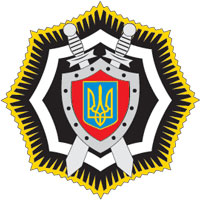
The militsiya was the national police service of Ukraine from the 1950s until 2015. The militsiya was formed whilst Ukraine was governed by the Ukrainian Soviet Socialist Republic, part of the Soviet Union, and continued to serve as a national police service in independent Ukraine until it was replaced by the National Police of Ukraine on 7 November 2015.

Ali Omarov - Prosecutor General of the Republic of Azerbaijan (1993-1994), Actual State Councillor of Justice.
Pavlo Meshyk was a Ukrainian KGB operative.

The Minsk City Police Department officially known as The Main Directorate of Internal Affairs of the Minsk City Executive Committee is the main municipal police force in the Belarusian capital of Minsk with responsibilities that include law enforcement and investigation in the city. Minsk has the largest number of police officers among the post-Soviet republics. It is also one of the most active police forces in Belarus due to Minsk being the center of many protests and arrests.





